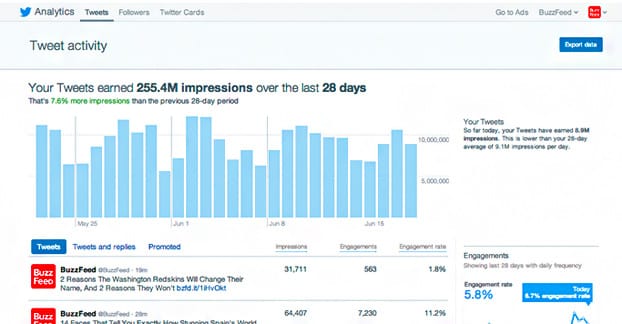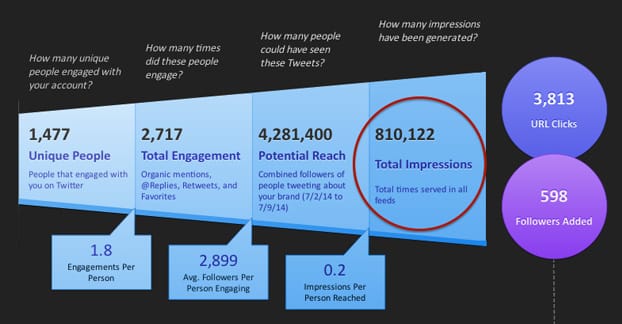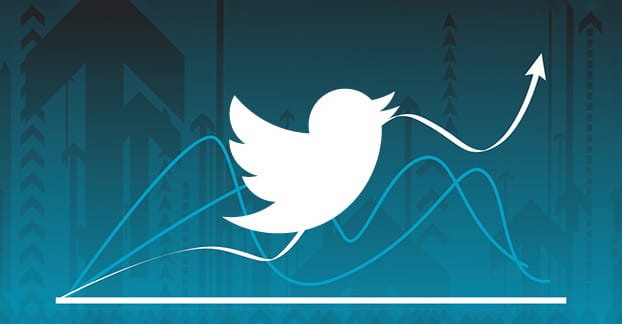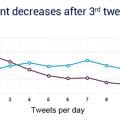About six or so months ago, Twitter updated their dashboard to show marketers a new piece of data; actual impressions. Previously, the only impression metric you were able to see was the potential impressions metric. Now the two are there, side by side, and it has led marketers the world over to ask; which is better? Which should we use?
As with most questions of a similar nature, there’s a valid use for both, and it will come down to what you’re trying to do. Not an easy answer, eh? Well, that’s what we get for living in such a complex world of digital data.
What Are Potential Impressions
Potential impressions are the number of times it’s possible that a tweet of yours could show up in the feed of someone else. If you make a tweet and you have 100 followers, that would be 100 potential impressions. Of course, it’s not quite that accurate; your tweets can still show up in search results, in retweets, and in a bunch of other locations. All of those are potential views, but there’s no way to tell whether or not someone actually saw them. A potential impression is just that; the potential for an impression.
Think about it like a sign on the side of the road. You can count every car that goes by as a potential impression, but not all of them are going to be real impressions. Some of them are looking at phones or talking to passengers. Some of them drive by at the same time as a truck that blocks their view. Some of them are focused on the road and don’t pay attention to the signs. Heck, there are a lot of people who will see your sign but not pay attention to read it, or even read it and immediately forget what it says when the next light turns green.
One thing to note is that potential impressions are distinct from reach. Reach is the number of people who might see your tweets. Potential impressions are the number of times your tweets might be seen. To go back to the car analogy, if one person drives up and down the road six times and passes your sign every time, that would be six potential impressions, but only +1 to your tweet’s reach.
Potential impressions are going to be high; probably a lot higher than you might expect. The reason for this is because it’s just counting every possible potential view you might get. The actual, real number of impressions you get is going to be much lower. If Kanye West retweeted one of your posts the potential impressions on that tweet would hit 23 million, but how many of those people are actually going to see the tweet?
In the past, you would simply have to calculate your actual impressions using one of a few different methods. These days, you can get data directly from Twitter.
What Are Actual Impressions?
Actual impressions are the new metric from Twitter that is an actual recording of the number of times your tweets are actually seen. It’s like recording a pageview or a link click; it’s a tangible metric that records an event that happens.
To use the car analogy again, it’s as if the sign has some kind of eye tracking and facial recognition capability and can record when it’s actually being read. The number of potential impressions is the number of people going by (including Kanye’s miles-long bus full of 23 million people) whereas the actual impressions is the number of people who are recorded reading the sign.
Unlike a pageview on Google Analytics, actual impressions are a pretty accurate measurement. A pageview can happen but not be tracked due to having scripts disabled, and a pageview can be tracked but not happen due to spoofing with bots and the like. Twitter impressions are more accurate.
Of course, it’s only a view as long as Twitter serves up the content. Bot accounts viewing your timeline still count, as will fake views on an embedded tweet on a website, as far as I know. Admittedly, I haven’t tested that one out.
Using Impressions
In most cases, the actual impressions metric is the one you want to care about. It doesn’t really matter if a bus full of people passes by if none of them look out the windows, right? Every impression that you don’t get is an impression that doesn’t matter. The only impressions that matter are the ones that actually happen.
Actual impressions are a good performance indicator for brand awareness and the comparison between impressions and reach. They’re more accurate for pretty much any calculation than potential impressions ever could be, and the metrics derived from potential impressions get more accurate when using actual impressions.
The primary use case for potential impressions is monitoring the potential success of your marketing. Think of it like a measurement of how many opportunities you have, that you could take advantage of. If your tweets have 10,000 potential impressions and 1,000 actual impressions, you have quite of bit of room to expand. That means you can track your improvement when you make changes. If you start to engage more with people and see your actual impressions double while your potential impressions stay the same, you know you’re doing something right.
Potential impressions can also be used for competitive analysis. If your competitors are getting significantly more potential impressions, you have to wonder where they’re coming from. Are they running more ads? Do they have influencers sharing their content? Are they embedding their feeds in their website frequently?
Potential impressions represent the largest possible audience you can reach but are not reaching. Actual impressions represent the people you are actually reaching from within that audience. Reach is the count of those people. Engagement rates are the number of people you get that not only see your tweets but engage with them in some way. Individual types of engagement are a more specific metric from there. It’s all about drilling down from the big picture.
Another thing to note is that neither type of impression is increased with manual retweets. Since a manual retweet is a copy and paste of your original tweet, it’s not tied to your account. You often get a mention and a quote, but you don’t get the actual impressions on your content. Thankfully, manual retweets are dropping since Twitter implemented the ability to add comments when you retweet.
Improving Impressions
Impressions are not necessarily the metric you want to focus on improving on Twitter. It’s great to get more eyes on your content, but think of it like paid ads. If you get 10,000 viewers and only get 5 link clicks, something is wrong with your audience. You’re going to benefit more from improving the click rate than you are from doubling the number of viewers your ad gets.
That said, as long as your other metrics are improving as well, getting more impressions will get you more of everything else. Thankfully, a lot of the tricks you can use to boost impressions also help to boost engagement rates, click rates, and other beneficial metrics.
First, establish monitoring. You want to see the impressions on your tweets, recorded in one place so you can see how well they do. Impressions tend to stop growing fairly quickly after a tweet is made, so you only have to wait a day or two to record for all but your most popular content. You want to see which messages get the most impressions and which get the least. Record metrics about them; when during the and during the week were they posted? What topic did they use? What hashtags did they use? Did they have links? Were they retweeted by particularly potent influencers? These are all factors you need to consider.
Next, establish a tweet format. Experiment with what works. If you find that using two hashtags is better than one, that’s great. If you find that @mentioning an influencer does a lot to get your content exposed to larger audiences, by all means, pick a few to cycle through. If you find quotes work better than teaser questions, use the quotes.
Possibly the best technique you can use is influencer marketing. Here’s the idea:
- Pick a couple dozen influencers in your niche. These should range from companies similar to yours who are not direct competitors, to top-tier performers in your niche, to high-visibility personalities.
- Write down some additional details for each of these accounts. I like to note down the category – low tier, high tier, business, personal account, etc – so I have an idea of what kind of entity I’m sharing with at a glance. I also like to write down the sort of content they tweet and retweet, since even within one niche there will be some variation. You can also note down in broad strokes how many people the account has following it. You don’t need to be any more specific than the nearest thousand; it’s just showing you a matter of scale.
- Start sharing links in tweets. I recommend a tweet that has a quote, a shortlink, a hashtag or two, and the @mention for your chosen influencer. Note: do not put the @mention at the front; that turns it into a reply, and replies are not visible to everyone.
- Monitor the outcome. Ideally, the account you mention will share, retweet, or reply to your comment. This will boost your impressions, and should hopefully boost your engagement, your link clicks, and even your follows.
- Note down the outcome in your spreadsheet. I mostly just note whether or not they retweeted, and if they did, how much more than the normal level of impressions I got out of it.
- Cycle through your list of influencers. Go from one to the next and see how each of them turns out. I like to go through the entire list two or three times before I start really drawing conclusions, because one single share can be a fluke but more than one can be the sign of a great budding relationship.
- Refine the list. The influencers who are underperforming – which might indicate they have fake followers – can be removed. The influencers that never share your content and thus don’t benefit you can be removed. The influencers that seem to love to share your content and comment on it can be bumped up in the rotation. Replace removed influencers with new influencers and continue the cycle.
Eventually you will build relationships with these influencers, grow your following, get more traffic to your site, and in general build up a successful presence on Twitter.
This can’t be your only strategy on Twitter, however. If all you ever post is self-promotional links with influencers tagged in them, you’re being very transparent about your intentions. You need to round out the corners with other kinds of content. To this end, I recommend a few things.
- Follow many of the influencers on your list and preemptively return the favor by sharing some of their content when you think it looks interesting and fits the marketing you want to portray.
- Follow the daily and weekly trends that Twitter shares on the sidebar. Some of those trends may be worth commenting on. This gives you a lot of impressions simply because when you use a trending hashtag, you reach the audience that’s talking about that tag and reading conversations in that tag.
- Post occasionally in an informal fashion about life, in a relevant way. Avoid the usual posts about pets or food, but post something that can be relatable to your audience.
With a campaign of influencer marketing, you can boost your impressions through the roof. What’s more, because of the source of those impressions and its relevance to your brand, you can get a lot of engagement, site clicks, and even conversions out of it.









Kenny Duff
says:I would like to know about converting traffic to clicks, any tips or tricks? Right now i am getting around 300,000 impressions a month, which 3 months ago would have sounded good, now i want to see real traffic resulting, any suggestions?